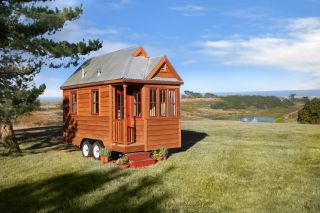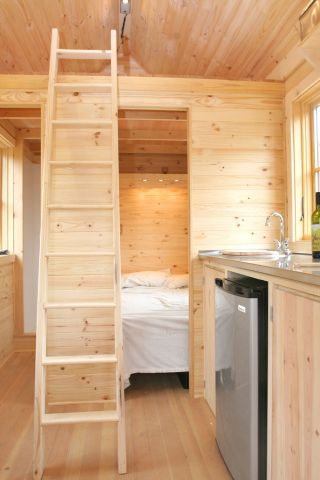
Attention
Creating Small, Environmentally Friendly Living Spaces
The tiny house movement and sustainable living
Posted May 10, 2013
Simplification has a different meaning for everyone. Individuals who simplify their lives engage in all types of practices ranging from selling off unnecessary possessions, going on “shopping diets”, embracing minimalist practices, changing jobs, moving from their home or location, or even going “off-the-grid” altogether.
One such simplifying practice, that often includes many of the above, involves living in a tiny house. So, what is a tiny house and what does living in one entail?

A tiny house
The small or tiny house movement has been developing quietly over the past decade and involves individuals who choose to live in a house that is much smaller than the typical American household. Individuals choose the tiny house lifestyle for various reasons but commonly cited motivations include environmental concern, financial freedom, and life simplification. Architect and author Sarah Susanka is credited with beginning the tiny house movement when she published The Not So Big House: A Blueprint for the Way we Really Live in 1997, which advocated to “build better, not bigger.”
Since her book, and especially after the housing-market bust in 2007-8, other individuals have signed on to the idea of quality over quantity when it comes to their home. Jay Shafer started the Tumbleweed Tiny House Company and co-founded the Small House Society in 2002 with Greg Johnson. The Small House Society was started in order to “support the research, development, and use of smaller living spaces that foster sustainable living for individuals, families, and communities worldwide.”
Because of the work of the Small House Society in tandem with books, Internet resources, blogs, and general media attention, the tiny house movement is growing. Tiny house living requires individuals to either build a tiny home or purchase the house itself from one of the (now) various tiny house purveyors. There is not one standard type of tiny house but there are some commonalities to tiny house living.
Tiny houses are small in size but not in character. At their smallest some tiny houses can be 65 square feet but some larger homes range up to almost 800 square feet. Many are typically 200 to 300 square feet and are often built on trailers to contend with size regulations for living spaces. Tiny houses built on trailers are able to avoid zoning and building codes that favor large living spaces. But even aside from the vague legalities of tiny homes, the ability to be mobile is often seen as a positive aspect of tiny living.
Tiny houses prioritize quality over quantity and aesthetics is an important factor when designing tiny homes. In short, tiny houses are beautifully cute. Many resemble mini cottages, inside and out. Though narrow, tiny homes have cozy yet complete living spaces- a sitting area, kitchen, bathroom, and sleeping loft. Because of the size, organization is key. Homes are often superbly streamlined while also striving for a warm and rustic atmosphere. The size and efficiency of tiny homes also promotes another important aspect of tiny living: an environmentally friendly and sustainable lifestyle.

Inside a tiny home.
Because tiny houses are, well, tiny, they require fewer resources to build and ultimately use less energy and create less waste once they are built. Tiny houses do not use as much electricity, water, or gas as a regular homes and they substantially reduce the inhabitants’ carbon footprint. The downside to tiny homes is that though they are more ecological and economical once built, building a tiny home requires custom construction and careful selection of core materials and systems. However, this is common downside to building any type of ecologically friendly dwelling and at least by keeping the home tiny, costs are reduced while also decreasing negative environmental impacts.
With a tiny house, sustainable living does not just come in the form of energy-use reduction. Because tiny houses use less energy, less money is spent on energy bills. Many proponents of the tiny house movement advocate for financial freedom and increased control over their quality of life. Tiny living gives individuals more control over their finances and often frees them from the burden of a mortgage and other payments that are incurred when living in a larger home. With tiny houses, it seems that less square footage boils down to lower housing costs and a reduction in harmful environmental consequences.
A reduction of square footage often entails a reduction of possessions and accumulation of unnecessary. Because of the nature of tiny houses, inhabitants of these spaces not only consume less energy but also tend to buy fewer items. Tiny homeowners are required to think through their needs and the space available in order to determine what items must absolutely be found in their home.
By shrinking their home, individuals in the tiny house movement reduce their environmental footprint, their housing costs, and their consumption resulting in an increasingly simplified existence. According to individuals who choose to live this way, lifestyle simplification is yet another positive benefit of tiny living. To them, tiny house living ultimately means a smaller, simpler, and more sustainable lifestyle.



